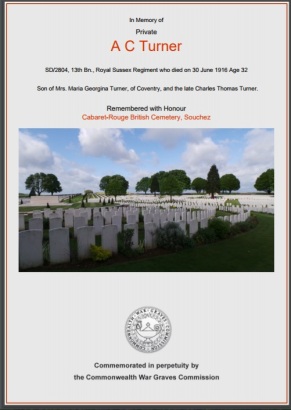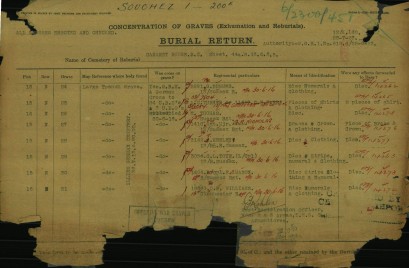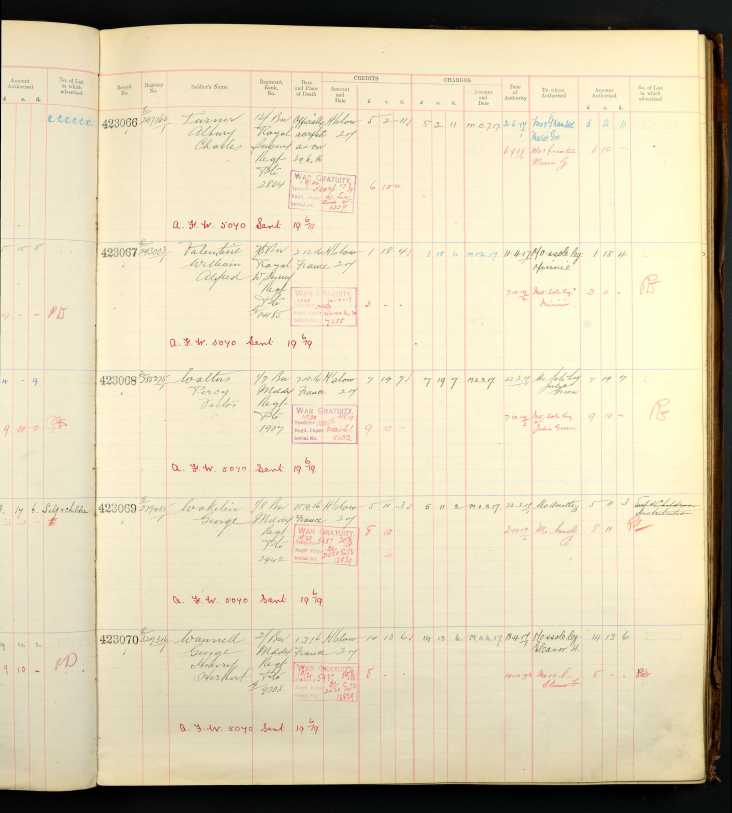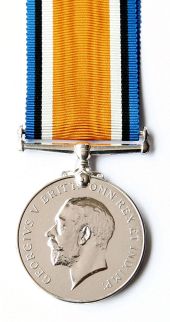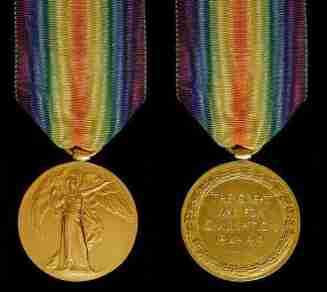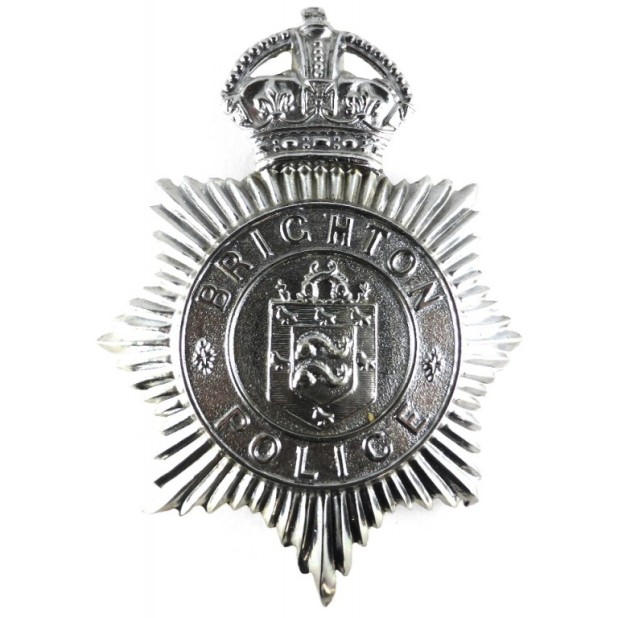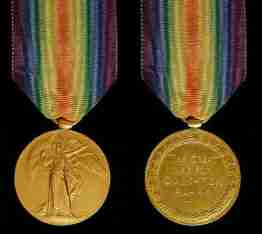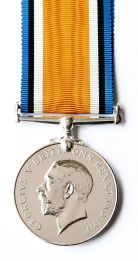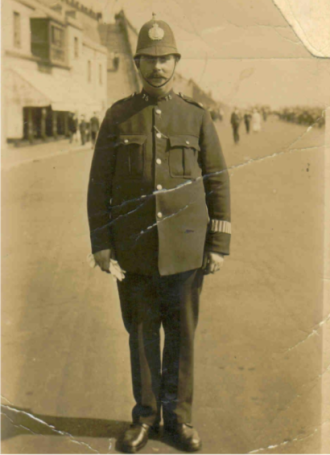Ernest Henry Lynn was born 22nd January 1890 in East Grinstead, Sussex. He died in 1975 in Brighton at the age of 80. His regiment was the Royal Sussex Regiment and his rank was sergeant with the service number 6815.
Family life
Ernest Henry Lynn was born on 22nd January 1890 in East Grinstead, Sussex. Although it cannot be certain he was probably born at 42 High Street, East Grinstead. It would appear that Ernest comes from a long line of Builders and Monumental Masons. His father, Grandfather and Great Grandfather are all Masons
Home life
Ernest is baptised in East Grinstead on 30th March 1890, His parents are shown as George Henry Lynn and Mary Jane Lynn. The 1891 Census of England and Wales finds Ernest as a 1yr old boy living with his family at 46 High Street, East Grinstead. His parents George and Mary were married in 1876. The marriage is registered at Steyning. Ernest has five elder siblings ; Florence Mary 13, Bernard George 10, Frederick Charles 8, Alice Lilian 6 and Henrietta Louisa 3.
The 1901 Census finds Ernest still at home with his father and siblings at 46 High Street, East Grinstead, Ernest is 11. His mother Mary does not appear on the Census and cannot at present be found. His brother Frederick who is now 18 is not on the Census and cannot be found either.
Ernest’s remaining siblings are all still living at home. Florence is 23 and is a Housekeeper, Bernard is 20 and is a Mason, Alice is 17 and is a Shop Assistant. Hernrietta is now 13.The 1911 Census of England and Wales find Ernest still living at home with his father at 46 High Street, East Grinstead. Ernest is now a Mason. He is single. Ernest’s father George is now 63yrs. He states that he is married and has been so for 34 years. There is still no trace of his wife Mary.
Bernard is still at home and is a 30 year old single Mason. Frederick Charles has returned home, he is married and is a Carpenter. He Married Fannie Istead and now has a son Reginald. Henrietta is now 23 and is a Housekeeper. Florence has left the family home and cannot at present be traced.
Ernest was a member of the 4th Royal Sussex Territorials which he left in order to become a Police Officer. On 6th July 1911 Ernest became a Police Constable with the Brighton Borough Police Force. It is not known where he was living at the time.
Military career
Ernest Henry Lynn appears on both WW1 Plaques within The Old Police Museum Cells at Brighton. He is shown to be with The Royal Sussex Regiment.
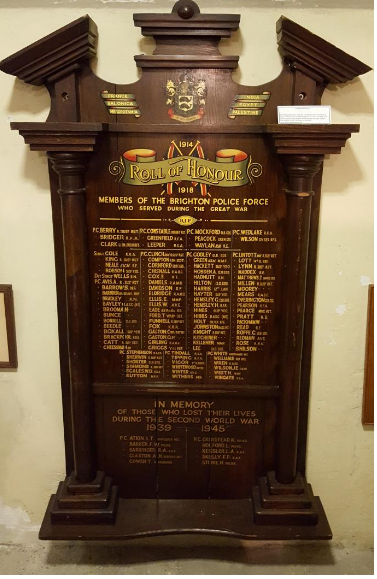
Police Cell Plaque
Ernest applied to the then Chief Constable of Brighton Borough Police William Gentle for permission to join the Army. With others, Arthur H Avis, Edward Eade, Edmund N Funnell, Christopher Gaston, Clifford Gaston, William Daniels, William J Berry, Frederick Stephenson, George Simmons, Samuel V Kitchener. Ernest Lynn was granted permission to leave on 12th May 1915. Ernest Lynn attested on 13th May 1915 at Brighton, Sussex along with William Berry for the Royal Sussex Regiment.
Ernest declared his age to be 25 years and 5 months old. He declared his father George, of 46 High Street, East Grinstead, Sussex to be his next of kin.
On 21st May, along with PC Avis, PC Catt, PC Cheesman, PC Lintott and PC Clinch he was posted to 10th Battalion Royal Sussex Regiment for training at Colchester until 13th September 1915. He was allocated service number GS/6823. (This is the number after Arhur Avis 6822 and before George Simmons 6824). His record shows the number prefixed with the letters “GS”, which was used to signify that the soldier was conscripted for “General Service”.
On 8th September Ernest passed a course of instruction in stretcher bearing and first aid. Catt, Avis, Cheesman, Clinch, Lintott and Millen were also on this course. Despite all the other Brighton Police Officers being posted to different battalions after initial training it would appear Ernest remained in the UK for just over 11 months.
On 1st October 1915 Ernest was promoted to Lance Corporal whilst remaining with the 10th Battalion where he remained until 1st March 1916 when he was promoted to Corporal. On 3rd March 1916 Ernest was posted to the Pioneer Depot Royal Sussex Regiment where he remained in the rank of Corporal until 30th May 1916 when he returned to the 10th Battalion.
On 29th June 1916, a year after several of his Police Colleagues had been in France Ernest is posted to join 9th Battalion Royal Sussex Regiment at the front. Ernest would have caught up with 9th Battalion Royal Sussex Regiment at a time when the Battalion was due to be relieved and moved by buses and trains away from the Ypres area and travelled to Montagne.
Ernest Lynn probably did not travel with the 9th but instead was posted to 7th Battalion Royal Sussex Regiment on 15th July 1916. He was promoted a Lance Sergeant. The 7th Battalion had been part of the “push” at the notorious Battle of the Somme around Ovillers and on 7th July was still fighting. The 7th Battalion had fought with great credit but suffered its highest number of deaths and casualties for any single day in the war. Twenty five officers and 650 other ranks went into the attack but only 5 officers and 220 other ranks remained unscathed. As a result of the severe losses suffered, the 7th Royal Sussex Regiment and 9th Royal Fusiliers were merged to form a battalion.
Ernest would have remained with 7th Battalion. Several more attacks were launched against the enemy in early August 1916 until they were sent for a well-earned rest but were soon to return in the area of Agny. The King and the Prince of Wales visited the Battalion on 10th August.
The Battalion remained in the area of Agny throughout September. October 1st brought the Battalion into the Somme front line once more, moving to the area of Flers and Gueudecourt. Front, support, and reserve trenches were shelled by the German for the first ten days. It was at this time that Ernest was wounded suffering from Shell Shock.
On 10th October 1916 Ernest was promoted to Sergeant.
The war continued for Ernest including his participation in the Battle of Arras and the third Battle of Ypres and the continued scramble of the Battle of the Somme.
October saw the 7th Battalion in intensive training near the 15th century battlefield at Agincourt which involved the first use of Tanks. They were training to be Tank support infantry. Upon completion the Battalion were involved in the first major tank offensive at the battle of Cambrai on 20th November 1917. This involved 380 tanks. The enemy were taken by surprise and their resistance was feeble. The 7th Battalion attained every one of their allotted objectives and it proved to be the most successful attack ever made by the 7th.
Early February found the 7th Battalion had moved to Doulieu. At 5.30 am on 4th February the Germans raided a post held by “A” Company, which resulted in the first injuries of 1918. Ernest Henry Lynn received Gunshot wounds to the neck and back and returned to England with his injuries. We next find Ernest being posted to the Royal Sussex regiment depot at Colchester on 25th February 1918.
On 25th November 1918 Ernest is posted to the Military Provost Staff Corps where he is basically a prison officer with the rank of Sergeant at a Military Corrective Training Centre at Aldershot. Ernest remains at this post until he is demobilized on 26th June 1919. His address was shown as 99 Queens Park Road, Brighton. Sussex. Ernest was awarded The British War Medal and Victory Medal. The medals below are not the actual medals issued to Lynn.
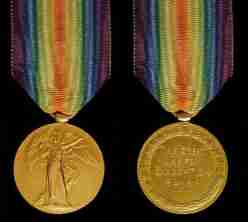
Victory Medal
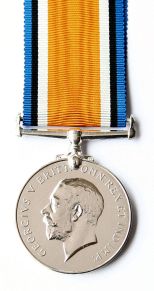
- British War Medal
Post war
It is known that Ernest rejoined the Brighton Borough Police after returning from the War. On 11th September 1929, Mary Jane Lynn, Ernest’s mother died. The Administration was granted to Ernest who is a Police Constable and his Sister Lilian. The 1939 Register is our next insight into Ernest, he is living at 3 Reading Road, Brighton. Ernest is shown as being a Retired Police Constable. He is shown as being born on 22nd January 1890.
Ernest is living with his wife Florence Agnes Cross whom he married at Newton Abbott, Devon in 1920. Her date of birth is shown as 26th March 1890. Further research reveals that Ernest and Florence had two children, Peggy Lynn born in 1921 and Ernest Lynn born in 1922. Florence died in 4th June 1952 at 45 Norton Road, Hove aged 62yrs.
Ernest Henry Lynn survived his wife for twenty three years. He died on 31st January 1975 aged 85yrs. His death is registered at Brighton.
Research problems
The only research problem was sorting out the sequence of events from within his army service records. Copyright Researched and reported by Ian Borthwick 2017, retired Sussex Police Officer AB579, served between Nov 1976 to March 2007.
 We’re off to Westminster Abbey in London this Sunday 11th November for the special centenary commemorations of World War I along with the Royal Family, for our work with Strike a Light-Arts & Heritage on The Orange Lilies: Brighton & Hove in the Somme project from 2016 onwards.
We’re off to Westminster Abbey in London this Sunday 11th November for the special centenary commemorations of World War I along with the Royal Family, for our work with Strike a Light-Arts & Heritage on The Orange Lilies: Brighton & Hove in the Somme project from 2016 onwards.














